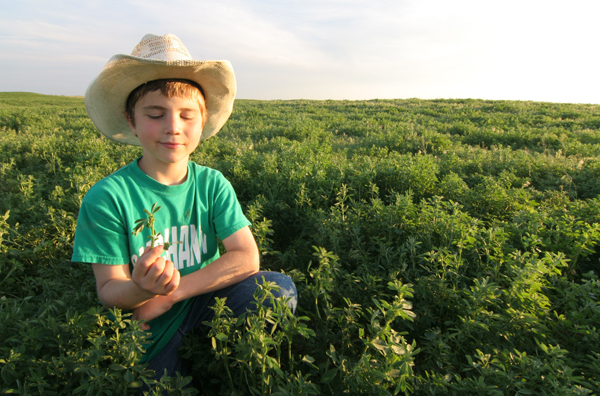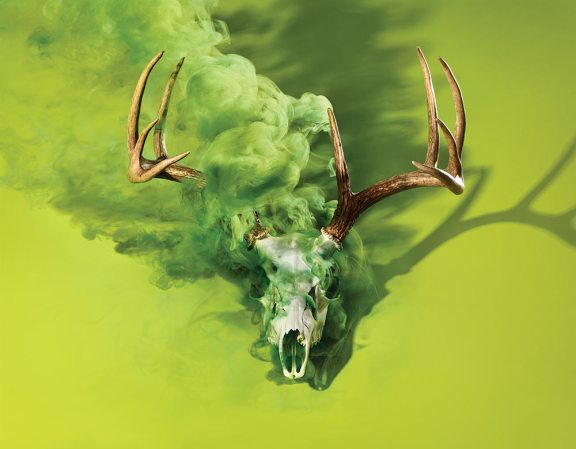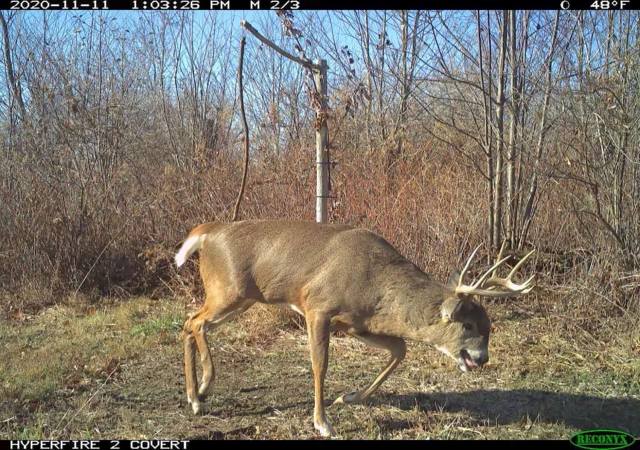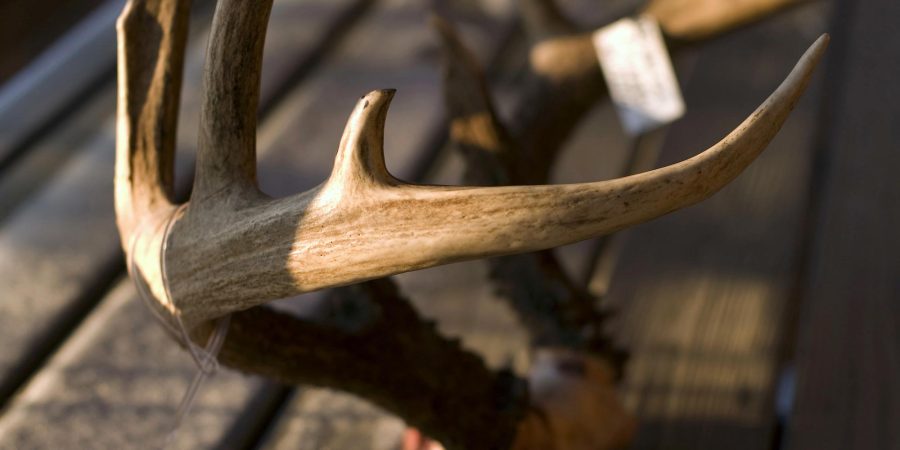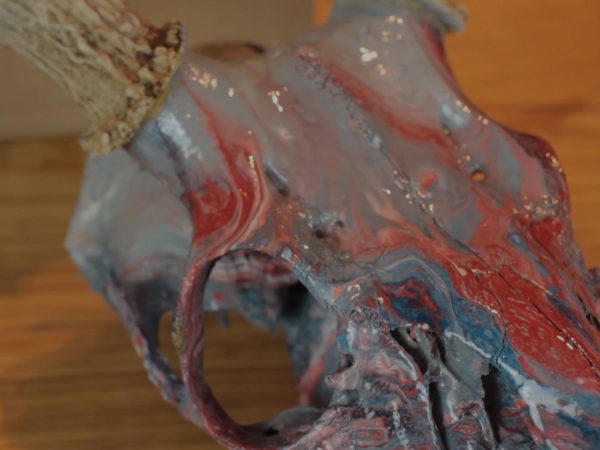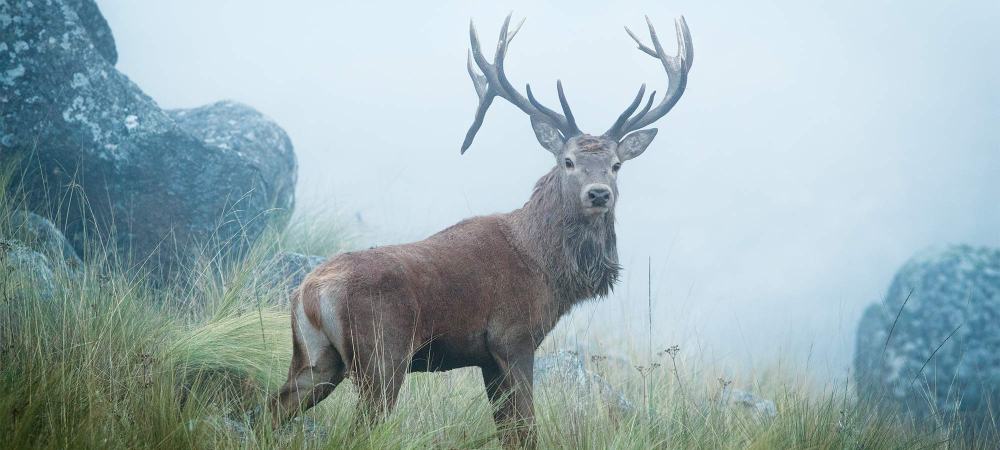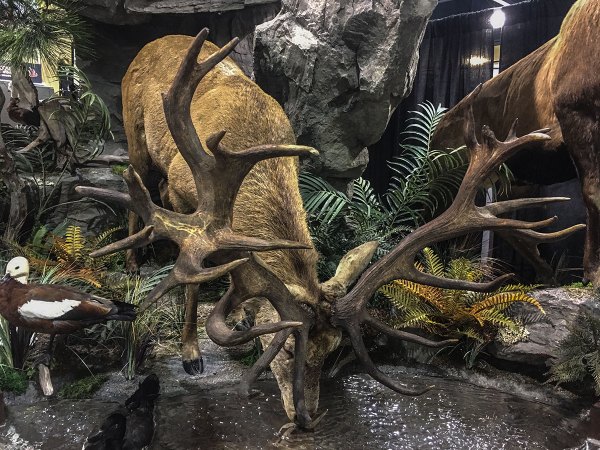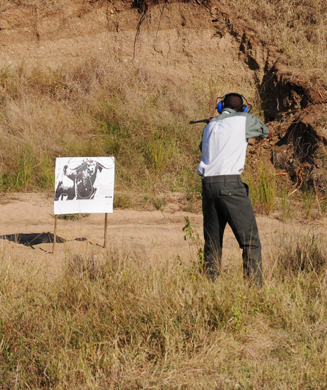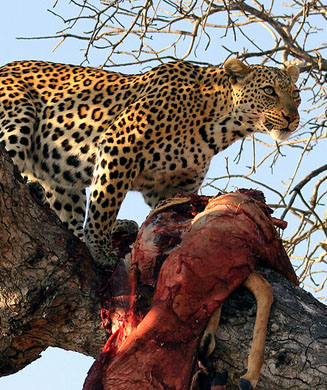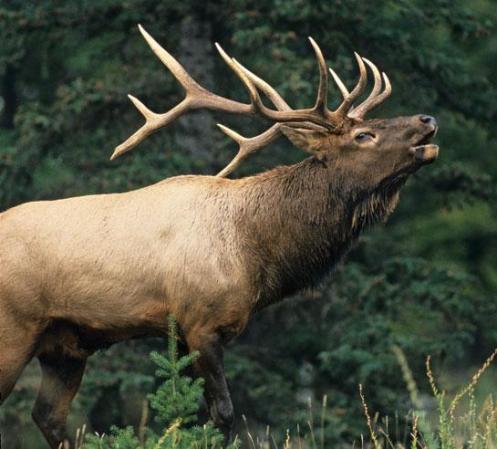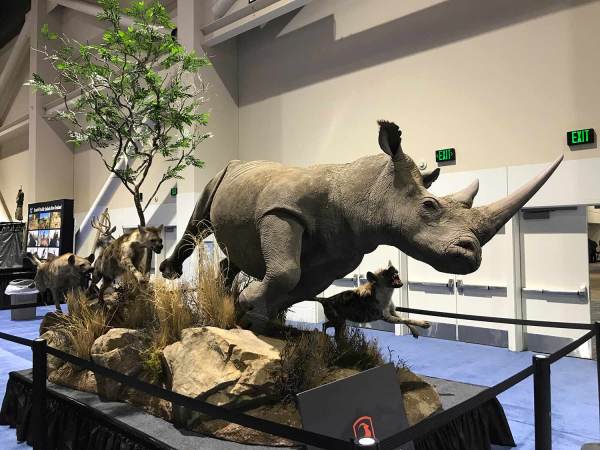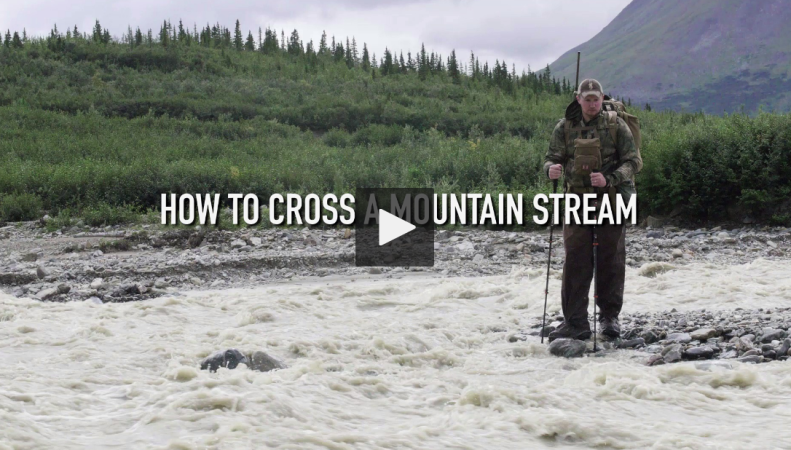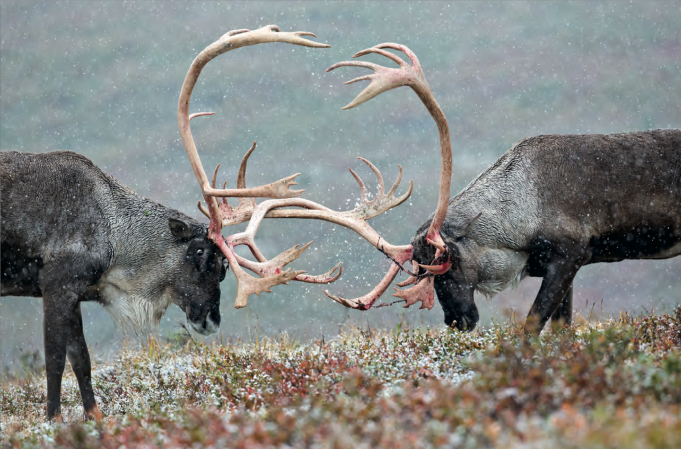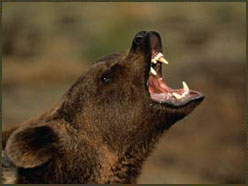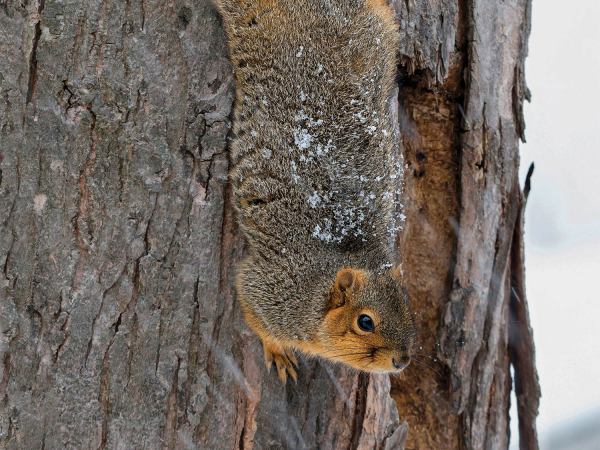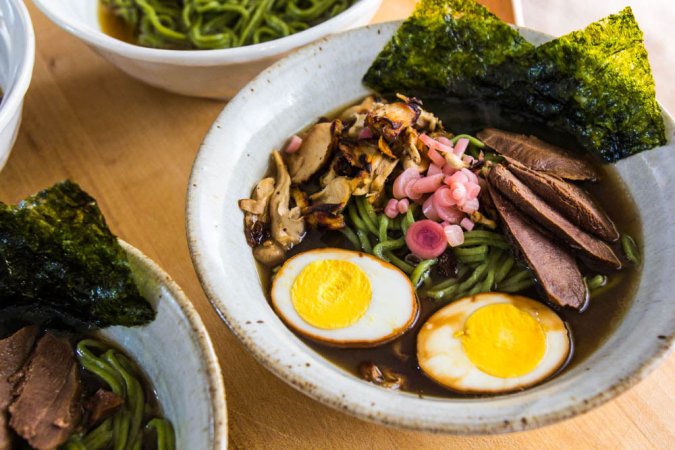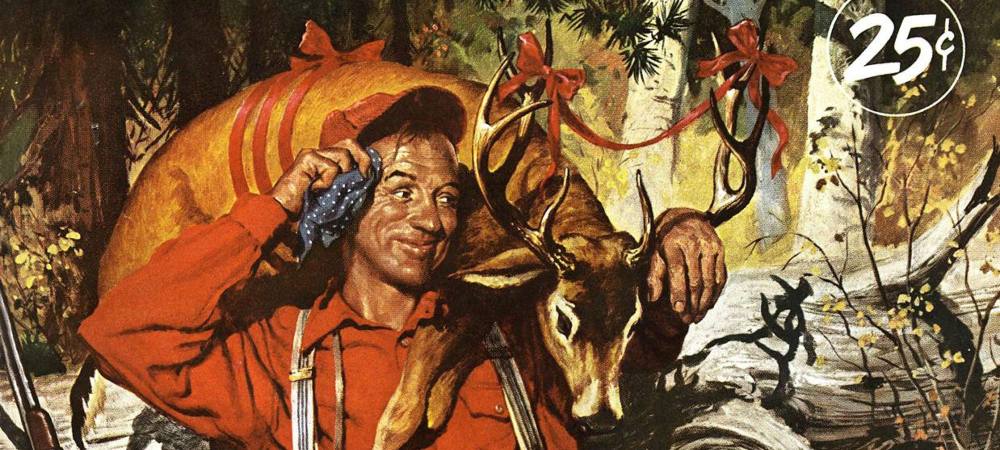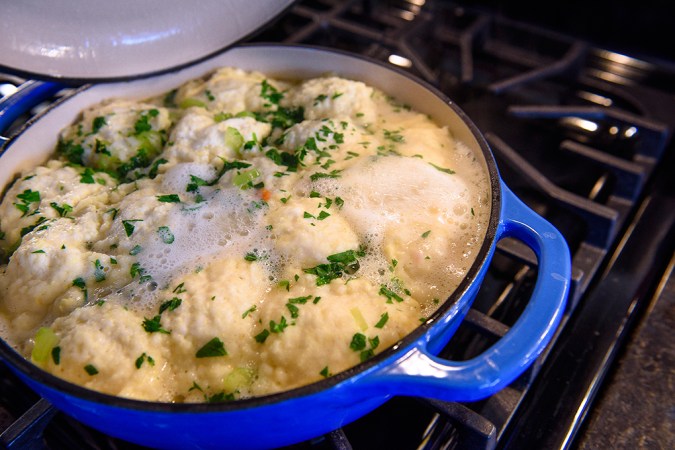The Limay River flows north and east out of Lake Nahuel Huapi on the western edge of the Rio Negro province in Argentina, its waters fed by the melting snows of the Andes. Where the river winds down through box canyons on its way to the Alicura dam, the waters are swift. In the dark eddies the sapphire pools hold giant rainbow trout.
The highway we traveled on last April followed the Limay for nearly two hours, past one spectacular fishing hole after another. In all that time I saw only two fishermen.
That’s the way it is in Argentina–a vast land comprising untold millions of acres of open country and virgin streams with no one to fish them. Had we come to fish, the temptation to pull over and wade into the cool waters would have been irresistible, but the cases stowed in the back of our van didn’t hold flyrods. Instead, they held a variety of rifles we’d brought in hopes of taking another trophy Argentina is famous for–red deer.
Like many Argentineans themselves, the red deer were transplants from Europe. Ranchers saw an opportunity for these animals to thrive in the vast open plains of the pampas that run along the eastern slopes of the Andes in Patagonia. The animals were introduced in 1922 and have been thriving ever since.
Red deer are somewhat smaller than elk, standing about 4 feet at the shoulder and weighing between 300 and 575 pounds, but they are similar in many ways. Males shed their antlers each season and, like our elk, red stags even have bugle teeth. Mature stags sport five or more points per side (good trophies carry at least 12 points). What makes the red stag totally unique, however, is that its antlers sweep out and up, culminating in clusters of “crown” points at the tips of the beams. On a good stag, these crown points are truly remarkable and very distinct. But why go nearly all the way to the tip of South America just to hunt deer?
One of the things I like best about hunting is that it opens doors to interesting new places. I’d never been to South America but I’d heard a lot about the red-deer hunting there, so when Tony Aeschliman of Marlin Firearms called to see if I’d be interested in heading to Argentina with him, I grabbed my calendar. Traveling to Argentina would be a chance to explore a whole new world with a fascinating culture, but there was more. I had already heard that the country was spectacular, and when I found that the area we’d be hunting was tucked up against the spine of the Andes separating western Argentina from Chile, I really began to get excited. “It’s a lot like Colorado,” Tony told me, conjuring up visions of my old stomping grounds on the east side of the Divide, where pine-covered mountains give way to high alpine basins and you can hear the elk for miles during the rut. When Tony explained that our hunt would be on horseback, I was sold. “When do we leave?” I asked.
April certainly doesn’t sound like a deer-hunting month, but in the southern latitudes (we’d actually be hunting on the 40th southern parallel) the seasons are exactly the opposite. April is springtime up north, but in Argentina, we’d he heading into fall and the rut. A horseback hunt in the heart of Patagonia on the edge of the rut? How could I say no? The only thing to decide was what guns to take.
For this advice I turned to OL Hunting Editor Jim Zumbo. I knew Jim had hunted red deer in Argentina before; what I didn’t know was that he had actually hunted the same ranch we’d be on. Zumbo explained that we’d be hunting elk-sized game in Colorado-like terrain. I pictured timbered hillsides like those we have in the West. And since we’d be on horseback, my first inclination was to reach for my Model 1895M in .450 Marlin. I love this little lever gun. It mounts quickly and was made to work with a saddle scabbard. Loaded with Hornady’s 350-grain Flat Point bullets, this gun hits like a fist. I’d taken both moose and wild pigs with this rifle. Topped with a low-power scope, it would be more than enough for red deer if I could get in close. Zumbo assured me that the guides were well-schooled at using the terrain to set up shots within 150 yards, so I figured I was all set. Once in Argentina, however, I wished I’d done a bit more homework.
Tony and I flew from New York to Miami, then on to Buenos Aires. The flight to Buenos Aires takes about 11 hours, which begins to give you some idea of just how far away Argentina really is. Once there, we switched to a domestic carrier and flew another two hours or so to San Carlos de Bariloche. Nestled in high mountains, Bariloche is a famous ski resort. The region is equally famous for fine chocolates. From Bariloche we traveled several hours by car along the Limay, marveling at the cottonwoods along the river. It looked right out of a scene from eastern Colorado, the leaves all yellow-gold in the autumn sun. At sundown we arrived at Algar, where we would be hunting.
Algar is a beautiful ranch encompassing 60,000 acres. Vast pampas, or plains, dominate the lower areas, which rise upward from about 3,000 feet to the peaks of the Andes. The accommodations were very comfortable and after checking the zero on our rifles and eating a hearty meal we headed for bed. Sliding under the warm wool blankets, I realized we had been traveling almost nonstop for 24 hours.
Before dawn the next morning we headed off to a distant part of the ranch, where our guide, Fabian, was waiting with our horses. Fabian Montes is a quiet man with dark brown eyes and an easy smile. Sitting astride his horse in knee-high riding boots, a rifle slung over one shoulder and a black beret atop a shock of coal-black hair, he reminded me of the Spanish revolutionaries of Hemingway’s For Whom the Bell Tolls. Like most gauchos (Argentinean cowboys), Fabian is very businesslike about guiding and is more comfortable riding a horse than most people are driving a car. He doesn’t waste minutes or movement, because that all detracts from the time to hunt, a task to which he is totally devoted.
Soon, Tony and I were mounted and our stirrups adjusted. Gaucho saddles are something of a cross between western and English saddles. The saddles themselves are deep and wide like our western saddles, but they don’t have a pommel and the stirrups are English-style. What’s more unusual, however, is that the gauchos cover their saddles with thick sheepskins. This provides a very cushy ride for passengers as well as a soft pillow to rest your head on at midday when the horses are unsaddled and you lie down for a siesta.
The nicest part about horseback hunting is that you get to see the land up close and at a much slower pace. As we ventured onto the high plains I began to realize just how vast the pampas really are. This great table land stretches south from the 38th parallel all the way to the Strait of Magellan. Its eastern border is the Atlantic Ocean; its western border is the Andes. We’d be hunting on only a tiny piece of it, but my first impression was that we were setting foot on lands that had not changed dramatically from the day they were formed. The sun was just rising over the golden plains, and the snow-capped Andes beckoned in the west. We rode for hours over open prairies. Occasionally, Fabian would stop to glass, pointing at groups of red deer in the distance. Finding red deer wasn’t a problem. They seemed to be everywhere. But I soon realized that the real challenge would be getting close enough for a shot before they spotted us. One look at our horses and, like Wyoming pronghorns, they darted off in the opposite direction. “This must be the way elk hunting on the plains was,” I thought as the hours drifted by.
At noon, Fabian found a dead tree far out on the plains and we dismounted for lunch. In minutes he had a fire going and gorgeous spare ribs roasting on the coals. This is what we’d come 10,000 miles for. Lying back on my sheepskin saddle blanket after lunch, I stared at the sky. Puffy white clouds skidded by and there was nothing–not a vehicle, not a house, not a telephone pole–as far as I could see. All I could hear was the chirping of crickets in the long grass.
And so our days fell into a rhythm. We’d wake before dawn and breakfast at the lodge, then mount up for the day’s ride across miles of open range. We made a number of stalks, sometimes leaving the horses and hiking on foot to check distant canyons. Once, we hiked up onto a plateau where we could hear several stags. The sound they make is very un-elklike, more of a roaring than an elk’s high-pitched whine. They were close, very close. We peeked over the lip of the ridge but all I could make out was antler tops. Fabian took one look and motioned for us to slip back to the horses. “Not big enough to shoot,” was all he said before motioning us to mount once more.
Another day Fabian broke the mid-morning silence. “Dos pumas,” he said, pointing ahead. Tony and I swept our eyes across the low-brushed pampas. “¿Donde estan?” I asked in my paltry Spanish. “Alli,” he said, pointing. But all I could see was grass. We rode ahead slowly, looking for the cats. Finally we saw them, a tawny blur sprinting 300 yards in front of us. They stopped just long enough for us to see that they were youngsters, their coats still a patchwork of black spots. Then they melted back into the golden grass and were gone.
As the days slipped by, others in our party began to fill their tags. Each night the skinners were busy tending to a new trophy. The filled tags freed up other guides, and on day five I left Tony with Fabian and trotted off into the rising sun with Emilio Millapi. Emilio was a jovial sort and we hit it off right away. He carried my .450 Marlin in case we got a shot up close, but I had accepted the offer from one of the hunters who had tagged out to borrow his New England Firearms Handi-Rifle in .30/06 in case a longer shot presented itself.
By sunup Emilio and I had traveled several miles and dropped down into a low riverine area. Once in the bottom, we left our horses and continued on foot, slipping between big clumps of pampas grass, the beige tufts of its long stems dancing in the breeze like flags. We belly-crawled in with the wind in our faces. The setup was perfect. Up ahead a large group of red deer was milling about. Several handsome stags traded insults as they craned their necks and roared at each other. One was very wide while the other had terrific crown points. Either would be a real prize, but in the dense pampas grass getting a shot was going to be tough. Finally, the deer decided for us and headed out of the riverbed with one of the big stags in the lead and the other following. We hunkered down, giving them time to clear the next rise before the two of us sprinted for the ridge. The breeze was still in our favor, but as we poked our heads over the top I realized that I had underestimated how quickly these animals can cover ground, even when they’re walking.
A quarter mile to the east, the wide stag was herding his females off at a trot, while 200 yards in front of us, the stag with the nice crown points was circling several other females. I quickly lay prone and slid my day pack into a natural dip in the ridge. Nestling in behind the gun I had a perfect dead rest. I quickly found the stag with the crown points in the scope. “¿Tiro?” I whispered. “Should I shoot?” Emilio was still looking at the wider stag a quarter mile or more away. In my broken Spanish the two of us had a quick powwow. Near as I could tell Emilio was offering me a choice. We could take our chances and try to catch up to the wider stag or take the stag in front of us with the gorgeous crowns. With but one day more to hunt, the choice for me was easy. I slipped off the safety and found the stag in the scope.
Now he was a good 250 yards out and getting farther away with each step. Unless the stag stopped, I wouldn’t get a shot. Finally, he slowed and turned broadside, stopping to see if there were any other females behind him. The rifle cracked and we could hear the whump of the bullet hitting home. I quickly broke the gun and dropped another cartridge into the chamber, but he was down. Emilio’s slap on my back startled me, but as I looked up at his broad smile, I knew the bull was ours. “Vamonos,” he said and the two of us slowly made our way to where the bull lay, each of us counting the paces. “Doscientos noventa y uno,” he said when we arrived. Two hundred ninety-one.
Up close the stag was everything I hoped he would be–nice and heavy, with great symmetry, his coarse coat and shaggy neck mane rippling in the morning breeze. He had broken one of his bez tines fighting, but that just added character. Emilio turned, his smile even broader now. “Esta muy bien,” he said. In fact, he was better than good. Grabbing the tips of his crown points the two of us counted…15 points. We traded back slaps again. It was 10 a.m.
In the end, everyone in our party had a good bull. Tony took it right down to the wire and shot a really nice stag the next morning. But we came home with much more than just trophies. I felt as though we’d traveled back to a place where time moves a little more slowly, the people appreciate the beauty that surrounds them a little more and life is good. Argentina, esta muy bien.
IF YOU GO
Outfitters: Our booking arrangements were made through Jack Atcheson & Sons, 3210 Ottawa, Butte, MT 59701; 406-782-2382; www.atcheson.com. The hunt was conducted in Argentina by Algar Safaris. Contact Liliana Saccomano, Ph: 5411-4912-7549; algar@fibertel.com.ar or visit www.algar-outfitters.com.ar.
Airlines/Customs: Buenos Aires is serviced by most of the major airlines (we flew American) with daily nonstop service out of Miami. We were greeted by an Algar representative who helped us with all of the firearms certificates to bring our guns into the country. He also transferred us to the smaller domestic airport across town, where we took an Aerolineas flight to Bariloche. Almost everyone spoke English, so communication was not a problem. Everyone we spoke to was very kind and friendly.
Trophies: Our trophies were expertly cleaned and packed by the skinners at Algar (who did some of the nicest work on trophies I’ve ever seen). We took them back with us as checked baggage. Though there was a slight additional fee for extra weight, it was well worth it. Attendants were on hand in Bariloche to shrink-wrap the antlers and capes and our trophies arrived home with us safe and sound.
Guns & Loads: Although the .450 Marlin Model 1895M I took is an ideal saddle gun and certainly powerful enough for red stag at moderate ranges, most of the country you’ll be hunting is extremely open. Hunters would be better served carrying flat-shooting calibers capable of good accuracy at ranges to 300 yards and beyond.
Loaded with Hornady’s 165-grain InterBond bullets, the New England Firearms Handi-Rifle in .30/06 I eventually borrowed to take my red stag was just about perfect. Others in our party used Hornady’s InterLock loads with equal success. High winds (it was rarely still) capable of causing bad bullet drifts are a constant factor, so heavier bullets per caliber are recommended.
Other Equipment: You’ll definitely want to bring a sturdy pair of hiking boots. (I wore cowboy boots but changed after my first day; they were useless for stalking on the rocky ground.) Good wind and rain gear is a must and I was very glad I had a warm hat and gloves to wear in the mornings. A good 8×30 or 10×40 binocular is also recommended, since you will spend a good deal of time glassing at long distances.

